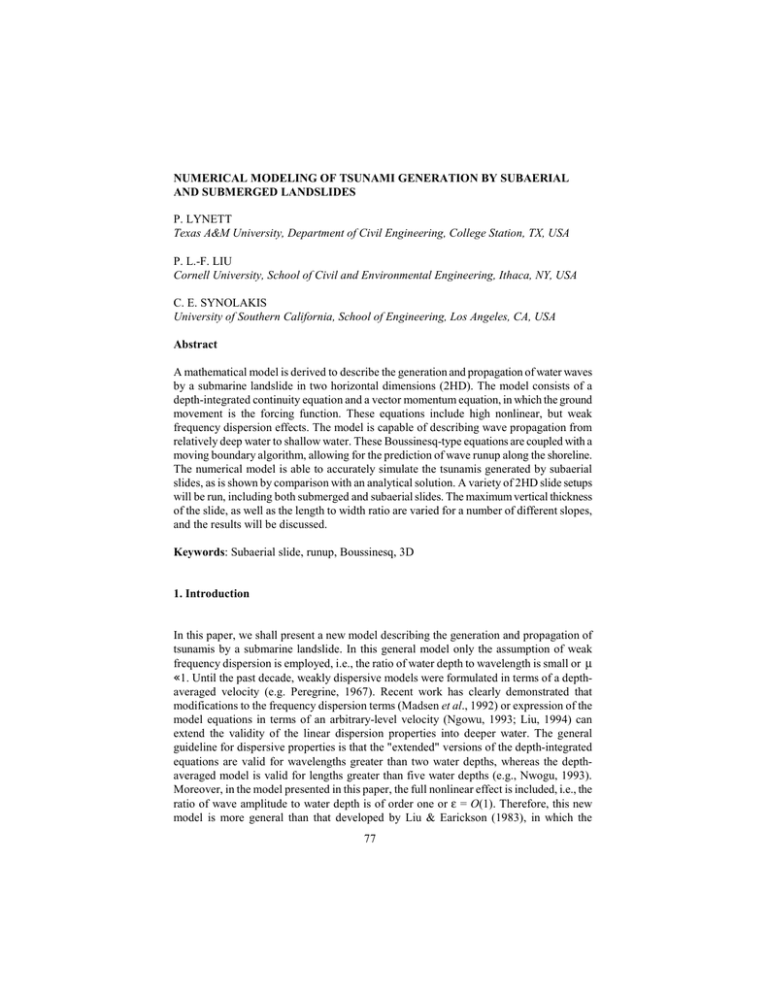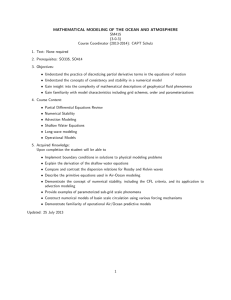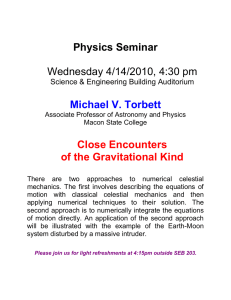P. LYNETT P. L.-F. LIU NUMERICAL MODELING OF TSUNAMI GENERATION BY SUBAERIAL
advertisement

NUMERICAL MODELING OF TSUNAMI GENERATION BY SUBAERIAL AND SUBMERGED LANDSLIDES P. LYNETT Texas A&M University, Department of Civil Engineering, College Station, TX, USA P. L.-F. LIU Cornell University, School of Civil and Environmental Engineering, Ithaca, NY, USA C. E. SYNOLAKIS University of Southern California, School of Engineering, Los Angeles, CA, USA Abstract A mathematical model is derived to describe the generation and propagation of water waves by a submarine landslide in two horizontal dimensions (2HD). The model consists of a depth-integrated continuity equation and a vector momentum equation, in which the ground movement is the forcing function. These equations include high nonlinear, but weak frequency dispersion effects. The model is capable of describing wave propagation from relatively deep water to shallow water. These Boussinesq-type equations are coupled with a moving boundary algorithm, allowing for the prediction of wave runup along the shoreline. The numerical model is able to accurately simulate the tsunamis generated by subaerial slides, as is shown by comparison with an analytical solution. A variety of 2HD slide setups will be run, including both submerged and subaerial slides. The maximum vertical thickness of the slide, as well as the length to width ratio are varied for a number of different slopes, and the results will be discussed. Keywords: Subaerial slide, runup, Boussinesq, 3D 1. Introduction In this paper, we shall present a new model describing the generation and propagation of tsunamis by a submarine landslide. In this general model only the assumption of weak frequency dispersion is employed, i.e., the ratio of water depth to wavelength is small or µ ©1. Until the past decade, weakly dispersive models were formulated in terms of a depthaveraged velocity (e.g. Peregrine, 1967). Recent work has clearly demonstrated that modifications to the frequency dispersion terms (Madsen et al., 1992) or expression of the model equations in terms of an arbitrary-level velocity (Ngowu, 1993; Liu, 1994) can extend the validity of the linear dispersion properties into deeper water. The general guideline for dispersive properties is that the "extended" versions of the depth-integrated equations are valid for wavelengths greater than two water depths, whereas the depthaveraged model is valid for lengths greater than five water depths (e.g., Nwogu, 1993). Moreover, in the model presented in this paper, the full nonlinear effect is included, i.e., the ratio of wave amplitude to water depth is of order one or ε = O(1). Therefore, this new model is more general than that developed by Liu & Earickson (1983), in which the 77 78 Lynett et al. Boussinesq approximation, i.e., O(µ ) = O(ε) ©1 was used. In the special case where the seafloor is stationary, the new model reduces to the model for fully nonlinear and weakly dispersive waves propagating over a varying water depth (e.g. Liu 1994, Madsen & Schaffer 1998). The model is applicable for both the impulsive slide movement and creeping slide movement. In the latter case the time duration for the slide is much longer than the characteristic wave period. 2 This paper is organized in the following manner. Governing equations and boundary conditions for flow motions generated by a ground movement are summarized in the next section. A numerical algorithm is presented to solve the general mathematical model. The prescribed slide shape and acceleration profile is then given. The numerical model’s ability to simulate waves generated by a subaerial slide is confirmed by comparison with an analytical solution. Finally, the numerical results for a 2HD slide are presented, where trends and relationships between output parameters such as runup will be correlated to the slide characteristics. 2. Governing Equations & Numerical Model The equation model utilized for the simulations presented in this paper are described in Lynett & Liu (2002), and will not be given here in any detail. This model has the robustness of enabling slide-generated surface waves, although initially linear or weakly nonlinear in nature, to propagate into shallow water, where fully nonlinear effects may become important. An alternative is to use different sets of governing equations, switching from a linear set to a nonlinear set as nonlinear effects become important. Although this approach may lead to significant computational benefits, one must empirically determine the switch point, which could differ for different physical setups. This numerical tuning is time consuming in itself, and could cancel the computational benefit of running the equationswitching model. The structure of the current numerical model is very similar to Wei & Kirby (1995) and Wei et al. (1995), with the added effects due to changing water depth in time. A high-order predictor-corrector scheme is utilized, employing a third order in time explicit AdamsBashforth predictor step, and a fourth order in time Adams-Moulton implicit corrector step (Press et al., 1989). The implicit corrector step must be iterated until a convergence criterion is satisfied. All spatial derivatives are differenced to fourth order accuracy, yielding a model that is numerically accurate to ( ∆x) , ( ∆y ) in space and ( ∆t ) in time. The governing equations are dimensionalized for the numerical model, and all variables described in this and following sections will be in the dimensional form. Runup and rundown of the waves generated by the submarine disturbance will also be examined. The moving boundary scheme employed here is the technique developed by Lynett et al. (2002). To simulate the effects of wave breaking, the eddy viscosity model (Zelt, 1991; Kennedy et al., 2000) is used here. Readers are directed to Kennedy et al. (2000) for a thorough description and validation of the breaking model, and the coefficients and thresholds given therein are used for all the simulations presented in this paper. 4 4 4 Numerical Modeling of Tsunami Generation 79 3. Numerical Simulations 3.1 SUBMARINE LANDSLIDES The comparison cases will use a slide mass travelling down a constant slope. The slide mass moves as a solid body, with velocity described following Watts (1997). This motion is characterized by a decreasing acceleration until a terminal velocity is reached. All of the solid body motion coefficients used in this paper are identical to those employed by Grilli & Watts (1999). The setup of the slide mass on the slope is shown in Figure 1. The time history of the seafloor is described by h( x, t ) = ho ( x) − ∆h x − xl x − x r 1 + tanh 1 − tanh S 2 S (1) where ∆h is the maximum vertical height of the slide, xl is the location of the tanh inflection point of the left side of the slide, xr is the location of the inflection point on the right side, and S is a shape factor, controlling the steepness of the slide sides. The right and left boundaries, and steepness factor are given by: xl (t ) = xc (t ) − Sb xr (t ) = xc (t ) + Sb (2) 1 S = cosθ 2 where xc is the horizontal location of the center point of the slide, and is determined using the equations governing the solid body motion of the slide. The angle of the slope is given by θ. The thickness of the "slideless" water column, or the baseline water depth, at the centerpoint of the slide is defined by hc(t)=ho(xc(t))=∆h+d(t). With a specified depth above the initial center point of the slide mass, do=d(t=0), the initial horizontal location of the slide center, xc(t=0), can be found. The length along the slope between xl and xr is defined as b, and all lengths are scaled by b. The reader is directed to Lynett & Liu (2002) for a thorough analysis of the waves generated by submerged slides when using depth-integrated models. The primary conclusion of said paper is the recommendation of a deep-water accuracy limit of the model. It was found that λ/hc>7, where λ is the horizontal length of the slide, for the model to be accurate. Within this limitation, the "extended" formulation of the depth-integrated equations shows no benefit over the "conventional", depth-averaged approach near the source region. Leading order nonlinear effects were shown to be important for prediction of shoreline movement, and the fully nonlinear terms are important for only the thickest slides with relatively short length scales. 80 Lynett et al. Figure 1. Setup for landslide comparisons. 3.2 SUBAERIAL LANDSLIDES As a preliminary check of the numerical model’s ability to simulate the tsunamis generated by a subaerial slide, the model is compared with a known analytical solution. Liu et al. (2002) presented a solution to the linear shallow water wave equations for the case of waves forced by a partially submerged landslide. The water depth profile is assumed to take the form: 2 (3) h( x, t ) = x tan β − d exp − (ξ − τ ) [ ] where β is the slope angle, d is the maximum vertical thickness of the slide mass, ξ =2 τ= x/λ , LLS tan β LLS (4) g t d (5) and LLS is a slide characterization parameter equal to λ tan β and λ is the horizontal d length of the slide. Liu et al. showed the free surface solution to this problem is ζ (ξ ,τ ) = ζ P (ξ ,τ ) + ζ H (ξ ,τ ) where: ζ P (ξ ,τ ) = [ 1 [1 + 2ξ (ξ − τ )]exp (ξ − τ )2 3 (6) ] (7) Numerical Modeling of Tsunami Generation ζ H (ξ ,τ ) = − ∞ ( ) 1 1 ω 6 − ω 2 J 0 [ωξ ]exp − ω 2 cos[ωτ ]dω ∫ 12 0 4 81 (8) ∞ ω 2 ω 2 π 1 2 2 2 2 − − − − − ω exp ω ( ω 6 ) I ( ω 2 ) I 0 1 J 0 [ωξ ]sin[ωτ ]dω 8 48 ∫0 8 8 and J0 is the Bessel function of the first kind of order zero, and I0 and I1 are the modified Bessel functions of the first kind of order zero and one, respectively. The analytic solution validity is limited to LLS>>1, due to its assumptions of frequency dispersion and nonlinearity. A comparison between this analytic solution and the numerical model, with nonlinear and dispersive terms truncated for consistency, is given in Figure 2. The two solutions agree very well, indicating that the numerical model correctly captures wave generation by a moving shoreline. Figure 2. Spatial snapshots of the analytical (solid line) and linear shallow water numerical model (dashed line) at four different times for a beach slope, β =10o, and LLS=3.5. The slide mass is indicated by the shaded area. With confidence in the ability of the numerical model to simulate tsunami generation by subaerial slides, we can utilize the more conventional slide shape described in section 3.1 for subaerial profiles. However, a slight modification to the prescribed motion must be made; the acceleration must be adjusted for cases where the slide mass is not completely submerged. A simple approach is taken, the velocity of the sliding mass is a weighted average of the aerial and submerged velocity, where the weighting is based on the fraction 82 Lynett et al. of the landslide submerged. The velocity along the slope of the center of mass of the slide is t (9) Slide velocity = f s ut tanh + f a gt sin β to where ut and to are the coefficients governing submerged solid body motion, and can be found in Grilli et al (2002), for example. The coefficients fs and fa represent the volume fractions of the landslide submerged and aerial, respectively, and of course must fall between 0 and 1, summing to 1. Figure 3 shows four spatial snapshots from a numerical run with do/b=-0.1 and ∆h/b=0.1, on a 1:10 slope. Figure 3. Tsunami generation by a subaerial landslide (dimensionalization has been done using b=1m). 3.3 2HD SIMULATIONS To model slides in 2HD, a transverse profile of the slide mass must be specified. In this study, a exponential profile is used, such that the slide mass is now given as: ∆h x − xl x − xr (10) h( x, y, t ) = ho ( x) − G ( y ) 1 + tanh 1 − tanh 2 S S where Numerical Modeling of Tsunami Generation 83 y − yo (11) G ( y) = exp− W yo is the centreline coordinate of the slide, and W is the slide width. An example numerical simulation of a 2HD slide is given in Figure 4. This slide has the same cross-sectional setup as the slide in Figure 4, with W/L=1. 2 Figure 4. Numerical results from a 2HD subaerial landslide. The dry area, i.e. the beach, is shaded in black. In the two early time plots (t=1,2 seconds), the sliding mass can be seen as the white ellipse on the beach. A leading elevation wave train is propagating offshore, and the intersection between the positive and negative elevation regions is shown by the white area. 3.3.1 Range of Parameters to be Tested For the 2HD slide profile described above, there are a number of variables whose effects need to be tested: W/L, the aspect ratio of the slide, β, the slope of the beach, do/b, the initial depth of submergence of the midpoint of the slide, and ∆h/b, the maximum vertical thickness of the slide. Over 500 2HD slides are currently in the process of simulation and analysis, and some conclusions will be given during our presentation. 84 Lynett et al. 4. Conclusions A depth-integrated model is presented that has the ability to simulate submerged and subaerial landslides in one- and two-horizontal dimensions. The accuracy of the submerged simulations has been shown in Lynett & Liu (2002), while the capability of the model to describe the waves created by subaerial slides is demonstrated here by comparison with an analytical solution. The great benefit of utilizing depth-integrated equations is their ease of use, as well as computational practicality, in regards to modeling 2HD wave propagation. We have briefly presented some of our 2HD landslide results in this paper, and will give a comprehensive summary of the numerical results during our presentation. 5. Acknowledgemts We would like to thank Dr. Cliff Astill, director of Geo-Hazard program at the National Science Foundation, for his continuous support (CMS-9908392). 6. References Chen, Y., & Liu, P. L.-F. 1995. Modified Boussinesq Equations and Associated Parabolic Model for Water Wave Propagation. J. Fluid Mech., 228:351--381. Grilli, S.T, and Watts, P. 1999. Modeling of Waves Generated by a Moving Submerged Body. Applications to Underwater Landslides. Engng. Analysis with Boundary Elements, 23:645-656. Grilli, S.T, Vogelmann, S., and Watts, P. 2002. Development of a 3D numerical wave tank for modelling tsunami generation by underwater landslides. Engng. Analysis with Boundary Elements, 26: 301-313 Kennedy, A. B., Chen, Q., Kirby, J. T., and Dalrymple, R. A. 2000. Boussinesq modeling of wave transformation, breaking, and runup. Part I: 1D. Journal of Waterway, Port, Coastal and Ocean Engng. 126(1):39-47. Liu, P. L.-F., 1994. Model Equations for Wave Propagations From Deep to Shallow Water. in Advances in Coastal and Ocean Engineering, Vol. 1 (ed. P.L.-F. Liu), 125-158. Liu, P. L.-F. & Earickson, J. 1983 A Numerical Model for Tsunami Generation and Propagation. in Tsunamis: Their Science and Engineering (eds. J. Iida and T. Iwasaki), Terra Science Pub. Co., 227-240. Liu, P. L.-F., Lynett, P, & Synolakis, C.E. 2002. Analytical solutions for forced long waves on a sloping beach. J. Fluid Mech., submitted. Lynett, P. and Liu, P. L.-F. 2002. A numerical study of submarine landslide generated waves and runup. Royal Society of London A in press. Lynett, P., Wu, T.-R., and Liu, P. L.-F. 2002. Modeling Wave Runup with Depth-Integrated Equations. Coast. Engrg. 46(2): 89-107. Madsen, P. A., and Sorensen, O. R., 1992. A new form of the Boussinesq equations with improved linear dispersion characteristics. Part II: A slowly varying bathymetry. Coast. Engng., 18:183-204. Madsen, P.A. & Schaffer, H.A., 1998. Higher-Order Boussinesq-type Equations for Surface Gravity Waves: Derivation and Analysis. Phil. Trans. R. Soc. Lond. A, 356:2123-3184. Nwogu, O., 1993 Alternative Form of Boussinesq Equations for Nearshore Wave Propagation. J. Wtrwy, Port, Coast and Ocean Engrg., ASCE, 119(6):618-638. Peregrine, D. H., 1967. Long Waves on a Beach. J. Fluid Mech. 27:815-827 Press, W.H., Flannery, B.P., & Teukolsky, S.A. 1989. Numerical Recipes. Cambridge University Press. 569-572. Watts, P. 1997. Water Waves Generated by Underwater Landslides, Ph. D. Thesis, California Institute of Technology. Wei, G. & Kirby, J. T. 1995. A Time-Dependent Numerical Code for Extended Boussinesq Equations. Journal of Waterway, Port, Coastal and Ocean Engng., 120:251-261. Wei, G., Kirby, J.T., Grilli, S.T., & Subramanya, R., 1995. A Fully Nonlinear Boussinesq Model for Surface Waves. Part 1. Highly Nonlinear Unsteady Waves. J. Fluid Mech. 294:71-92. Zelt, J. A. 1991.The runup of nonbreaking and breaking solitary waves. Coast. Engrg., 15:205-246.


